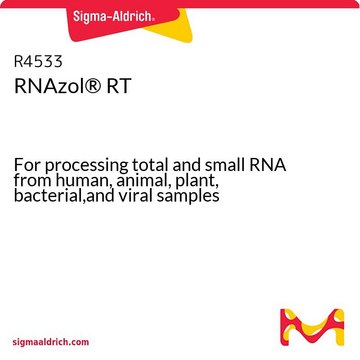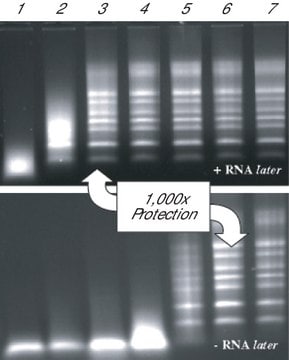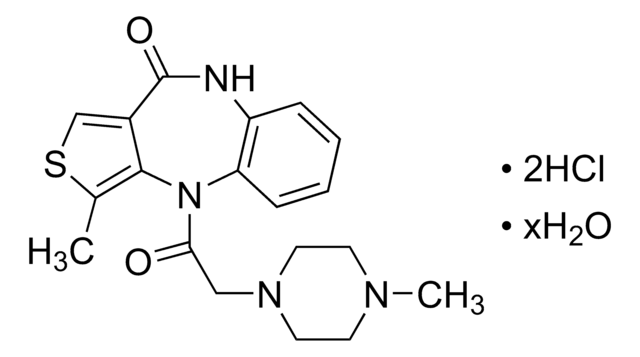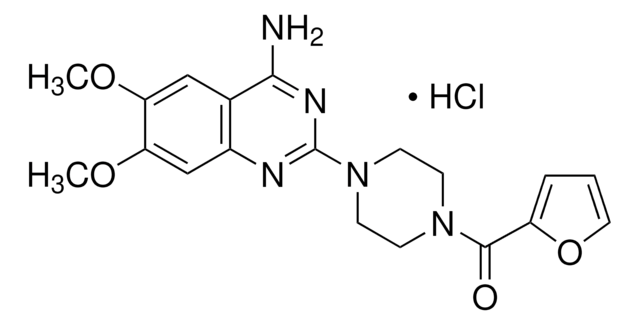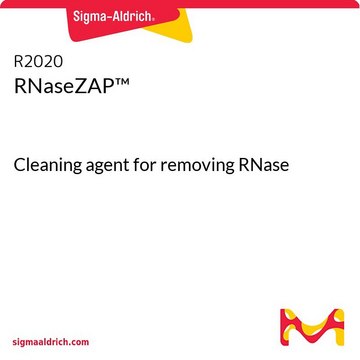Key Documents
T9424
TRI Reagent®
For processing tissues, cells cultured in monolayer or cell pellets
Synonim(y):
DNA/RNA/protein extraction reagent, DNA/RNA/protein isolation reagent, DNA/RNA/protein purification reagent, TRI Reagent® cell pellet solution, cell pellet RNA extraction, cell pellet RNA isolation, cell pellet RNA purification, single step RNA extraction reagent, single step RNA isolation reagent, single step RNA purification reagent, total RNA extraction solution, total RNA isolation solution, total RNA purification solution, TRI Reagent® RNA Isolation Reagent
About This Item
Polecane produkty
Poziom jakości
zastosowanie
mL sufficient for 107 cells
mL sufficient for 100 mg tissue (or)
temp. przechowywania
2-8°C
Szukasz podobnych produktów? Odwiedź Przewodnik dotyczący porównywania produktów
Opis ogólny
Homogenization or lysis of the tissue sample in TRI reagent® dissolves RNA, DNA and protein. The addition of chloroform or 1-bromo-3-chloropropane followed by centrifugation results in the separation of the mixture into three phases: an aqueous phase containing the RNA, the interphase containing DNA, and an organic phase containing proteins. Each of the components can then be isolated after separating the phases.
Zastosowanie
- in the isolation of total RNA from various tissue samples and cells
- for the lysis of monocytes
- to isolate cytoplasmic RNA from SARS-CoV infected Vero cells
- to isolate total RNA from MDMs (monocyte-derived macrophages) infected with influenza A (H5N1) virus
- to prepare a viral lysate of SARS-CoV culture for the creation of a clone encoding the S glycoprotein in the development of SARS-CoV vaccine
The RNA, DNA and protein that are isolated using TRI reagent® can further be used for downstream applications, such as cloning, PCR, RT-PCR, Northern blots, mRNA isolation, in vitro translation, RNase protection assay, restriction enzyme digestion, Southern blots, SDS-PAGE and western blots.
Cechy i korzyści
Multi-purpose: TRI Reagent® performs well with large or small amounts of tissue or cells and works with many samples including human, plant, yeast, bacterial and viral samples.
Efficient: TRI reagent® gives better yields than traditional guanidine thiocyanate/cesium chloride methods. The whole process of RNA extraction starting with fresh tissue or cells can be completed in less than one hour.
- Easily scalable RNA isolation
- Works with many sources: human, plant, yeast, bacterial, or viral
- Better yields than traditional guanidine thiocyanate/cesium chloride methods
Informacje prawne
produkt powiązany
Hasło ostrzegawcze
Danger
Zwroty wskazujące rodzaj zagrożenia
Zwroty wskazujące środki ostrożności
Klasyfikacja zagrożeń
Acute Tox. 3 Dermal - Acute Tox. 3 Inhalation - Acute Tox. 3 Oral - Aquatic Chronic 2 - Eye Dam. 1 - Muta. 2 - Skin Corr. 1B - STOT RE 2
Organy docelowe
Nervous system,Kidney,Liver,Skin
Zagrożenia dodatkowe
Kod klasy składowania
6.1A - Combustible acute toxic Cat. 1 and 2 / very toxic hazardous materials
Klasa zagrożenia wodnego (WGK)
WGK 2
Temperatura zapłonu (°F)
174.2 °F - closed cup
Temperatura zapłonu (°C)
79 °C - closed cup
Certyfikaty analizy (CoA)
Poszukaj Certyfikaty analizy (CoA), wpisując numer partii/serii produktów. Numery serii i partii można znaleźć na etykiecie produktu po słowach „seria” lub „partia”.
Masz już ten produkt?
Dokumenty związane z niedawno zakupionymi produktami zostały zamieszczone w Bibliotece dokumentów.
Klienci oglądali również te produkty
Produkty
The availability of simple methods for purification of DNA and RNA has greatly facilitated the analysis and characterization of the genome and gene expression. There is a demand to isolate DNA and RNA rapidly and conveniently from a variety of cellular sources, including cells and tissues from mammalian, plant and bacterial cultures.
Proste metody oczyszczania DNA/RNA wspomagają analizę genomu z różnych źródeł, zwiększając efektywność badań.
Protokoły
Cultrex™ 3-D Culture Cell Harvesting Kit provides an optimized and standardized solution for the isolation and normalization of cell lysates from 3-D Culture Matrix™ BME or Laminin I for subsequent biochemical analysis.
Odczynnik TRI umożliwia jednoczesną izolację DNA, RNA i białek z wytycznymi dotyczącymi przygotowania próbek i rozwiązywania problemów.
TRI Reagent is a single-step RNA isolation reagent that allows simultaneous isolation of DNA, RNA and protein. This protocol outlines sample prep as well as extraction of the various samples and troubleshooting.
Protocol for Anti Ago-RNA Immunoprecipitation from mammalian cells using the RIP kit
Powiązane treści
Metody lizy komórek i ekstrakcji białek obejmują przegląd różnych technik, od rozpuszczania detergentami po mechaniczne rozbijanie, wspierając potrzeby badawcze.
An overview of cell lysis and protein extraction methods including detergent solubilization, freeze-thaw lysis, osmotic shock, sonication, enzymatic cell lysis, and mechanical disruption techniques such as Dounce, Polytron, and mortar and pestle homogenization.
Metody lizy komórek i ekstrakcji białek obejmują przegląd różnych technik, od rozpuszczania detergentami po mechaniczne rozbijanie, wspierając potrzeby badawcze.
Nasz zespół naukowców ma doświadczenie we wszystkich obszarach badań, w tym w naukach przyrodniczych, materiałoznawstwie, syntezie chemicznej, chromatografii, analityce i wielu innych dziedzinach.
Skontaktuj się z zespołem ds. pomocy technicznej


